BOOK OF HOURS, use of Paris, in Latin, illuminated manuscript on vellum [Paris, c.1520] A lavish Book of Hours rich in both text and illumination, constituting a telling demonstration of the cross-currents and common interests of those involved in the production of printed and manuscript books in Paris in the first decades of the 16th century. 83 x 127mm. 148 leaves (lacking one leaf after f.10), pencil foliation 1-145, repeating ff.51-53, followed here, every page with a full-page border with sprays of acanthus and naturalistic flowers on a liquid gold ground, twelve bi-partite calendar miniatures, with occupations of the month and zodiac signs, seven historiated initials, forty-eight small miniatures and nineteen large miniatures (slight cropping of outer border to Calendar leaves, some minor smudging and rubbing to some borders, small pigment losses to two large and four small miniatures, smudging to initial on f.20). 19th-century green velvet (boards detached). Provenance : The Hours was illuminated for a woman represented in prayer before Christ on the Cross (f.132) and before the risen Christ (f.125v) — E.P. Dutton and Co, rare book dealers, New York. Content : Calendar ff.1-6v; Gospel Extracts ff.7-10v; O Beatissime d[omi]ne Iesu christe followed by Passion according to St John (lacking opening) ff.10v-16; Obsecro te and O Intemerata and other prayers ff.16v-29; Office of the Virgin, use of Paris, interspersed with Hours of the Cross and Holy Spirit after lauds ff.30-72v; Hours of the Conception of the Virgin ff.70-75v; Suspice d[omi]ne sancte pater om[ni]p[oten]s eterne deus ff.75v-76; Seven Penitential Psalms and Litany ff.76v-90v; Office of the Dead, use of Paris, ff.91-114v; Suffrages ff.115-129; prayers, to St Gregory, the Virgin, of protection against sudden death etc. ff.129v-136v; Verses of St Bernard ff.137-138; Indulgenced prayers and prayers to be said at different times of the day ff.138-142v; Fifteen Joys of the Virgin ff.142v-145; prayer added in a contemporary or near contemporary hand f.145v. The subjects of the large miniatures are: John on Patmos f.7; Creation of Eve f.29v; Annunciation f.30; Visitation f.42v; Crucifixion f.48v; Pentecost f.49v; Nativity f.50v; Annunciation to the shepherds f.51v; Adoration of the Magi f.54v; Flight into Egypt f.60v; Coronation of the Virgin f.65; Entombment of Christ f.68; Christ appearing to the Virgin f.69; Meeting at the Golden Gate f.70; Virgin of the Litanies f.74v; David in penitence f.77; Job on the dungheap f.91; Trinity f.115; Mass of St Gregory f.129v. The paired scenes of the occupation and zodiac sign relevant to each month of the Calendar are on rectos and versos of folios 1-6. The small miniatures are on ff. 8, 9, 10, 115v, 116, 116v, 117, 117v, 118, 118v, 119 (x2), 119v, 120, 120v (x2), f.121, 121v, 122, 123, 123v (x2), 124, 124v (x2), 125, 125v, 126 (x2), 126v, 127 (x2), 127v, 128, 129, 130, 130v, 131, 131v (x2), 132, 133, 134, 137. The historiated initials are on ff. 16v, 18v, 20, 21v, 25v, 26, and 27v. The illumination is an early example of the work of Etienne Collault an artist employed by the King and Court in Paris and was paid in 1523 and 1528 for illuminating twelve copies of the Statues of the Order of St Michel. The feast of the Immaculate Conception was first authorized for Paris in 1497 and the Office became an increasingly frequent inclusion in Books of Hours. If illustrated, it was introduced with the Meeting at the Golden Gate. In 1503 the Parisian publisher Antoine Vérard printed an Hours for the use of Rouen where the Office was illustrated with a woodcut showing the Virgin surrounded by 15 symbols of her purity. It makes only an occasional appearance in manuscripts; in the present manuscript, however, the customary subject opens matins of the Office while the Virgin and her emblems, known as the Virgin of the Litanies, opens compline. With manuscript illuminators painting printed books and designing metal- or wood-cuts fo
BOOK OF HOURS, use of Paris, in Latin, illuminated manuscript on vellum [Paris, c.1520] A lavish Book of Hours rich in both text and illumination, constituting a telling demonstration of the cross-currents and common interests of those involved in the production of printed and manuscript books in Paris in the first decades of the 16th century. 83 x 127mm. 148 leaves (lacking one leaf after f.10), pencil foliation 1-145, repeating ff.51-53, followed here, every page with a full-page border with sprays of acanthus and naturalistic flowers on a liquid gold ground, twelve bi-partite calendar miniatures, with occupations of the month and zodiac signs, seven historiated initials, forty-eight small miniatures and nineteen large miniatures (slight cropping of outer border to Calendar leaves, some minor smudging and rubbing to some borders, small pigment losses to two large and four small miniatures, smudging to initial on f.20). 19th-century green velvet (boards detached). Provenance : The Hours was illuminated for a woman represented in prayer before Christ on the Cross (f.132) and before the risen Christ (f.125v) — E.P. Dutton and Co, rare book dealers, New York. Content : Calendar ff.1-6v; Gospel Extracts ff.7-10v; O Beatissime d[omi]ne Iesu christe followed by Passion according to St John (lacking opening) ff.10v-16; Obsecro te and O Intemerata and other prayers ff.16v-29; Office of the Virgin, use of Paris, interspersed with Hours of the Cross and Holy Spirit after lauds ff.30-72v; Hours of the Conception of the Virgin ff.70-75v; Suspice d[omi]ne sancte pater om[ni]p[oten]s eterne deus ff.75v-76; Seven Penitential Psalms and Litany ff.76v-90v; Office of the Dead, use of Paris, ff.91-114v; Suffrages ff.115-129; prayers, to St Gregory, the Virgin, of protection against sudden death etc. ff.129v-136v; Verses of St Bernard ff.137-138; Indulgenced prayers and prayers to be said at different times of the day ff.138-142v; Fifteen Joys of the Virgin ff.142v-145; prayer added in a contemporary or near contemporary hand f.145v. The subjects of the large miniatures are: John on Patmos f.7; Creation of Eve f.29v; Annunciation f.30; Visitation f.42v; Crucifixion f.48v; Pentecost f.49v; Nativity f.50v; Annunciation to the shepherds f.51v; Adoration of the Magi f.54v; Flight into Egypt f.60v; Coronation of the Virgin f.65; Entombment of Christ f.68; Christ appearing to the Virgin f.69; Meeting at the Golden Gate f.70; Virgin of the Litanies f.74v; David in penitence f.77; Job on the dungheap f.91; Trinity f.115; Mass of St Gregory f.129v. The paired scenes of the occupation and zodiac sign relevant to each month of the Calendar are on rectos and versos of folios 1-6. The small miniatures are on ff. 8, 9, 10, 115v, 116, 116v, 117, 117v, 118, 118v, 119 (x2), 119v, 120, 120v (x2), f.121, 121v, 122, 123, 123v (x2), 124, 124v (x2), 125, 125v, 126 (x2), 126v, 127 (x2), 127v, 128, 129, 130, 130v, 131, 131v (x2), 132, 133, 134, 137. The historiated initials are on ff. 16v, 18v, 20, 21v, 25v, 26, and 27v. The illumination is an early example of the work of Etienne Collault an artist employed by the King and Court in Paris and was paid in 1523 and 1528 for illuminating twelve copies of the Statues of the Order of St Michel. The feast of the Immaculate Conception was first authorized for Paris in 1497 and the Office became an increasingly frequent inclusion in Books of Hours. If illustrated, it was introduced with the Meeting at the Golden Gate. In 1503 the Parisian publisher Antoine Vérard printed an Hours for the use of Rouen where the Office was illustrated with a woodcut showing the Virgin surrounded by 15 symbols of her purity. It makes only an occasional appearance in manuscripts; in the present manuscript, however, the customary subject opens matins of the Office while the Virgin and her emblems, known as the Virgin of the Litanies, opens compline. With manuscript illuminators painting printed books and designing metal- or wood-cuts fo
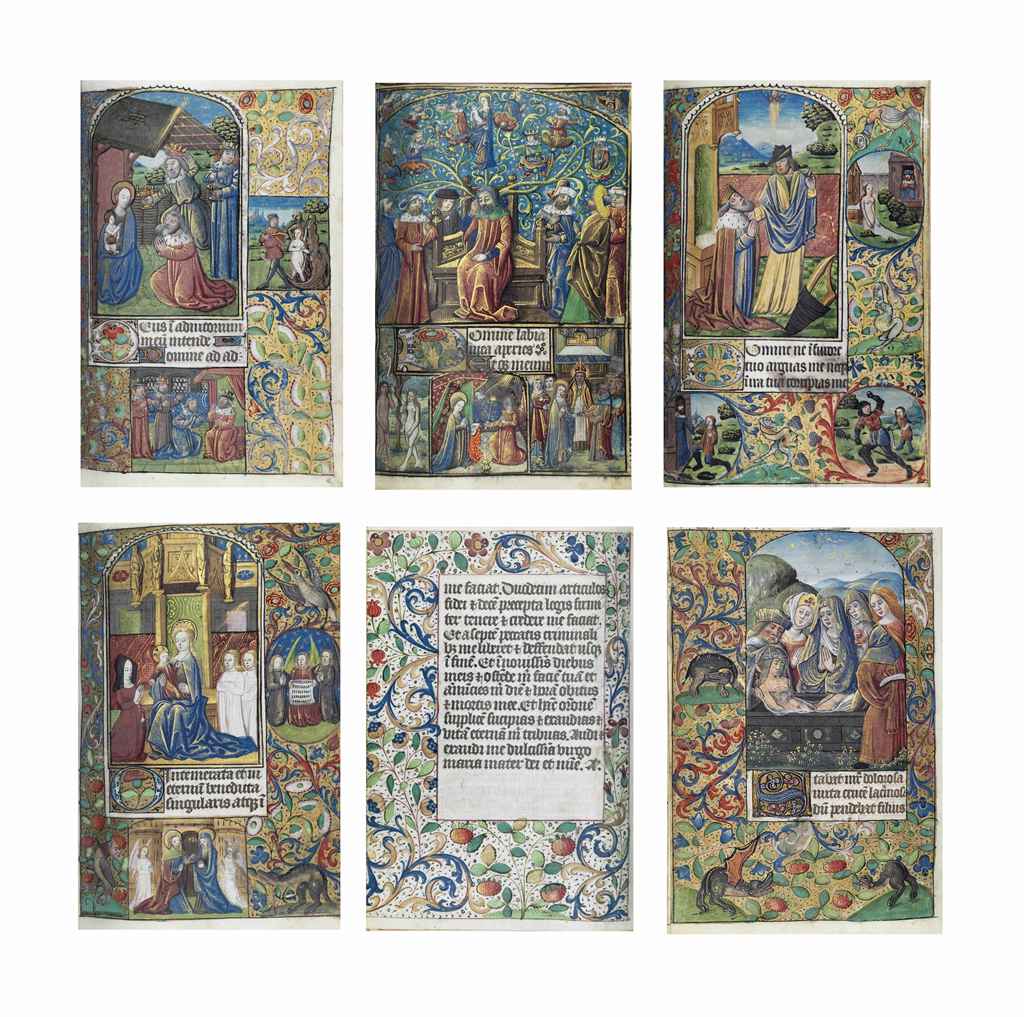
.jpg)
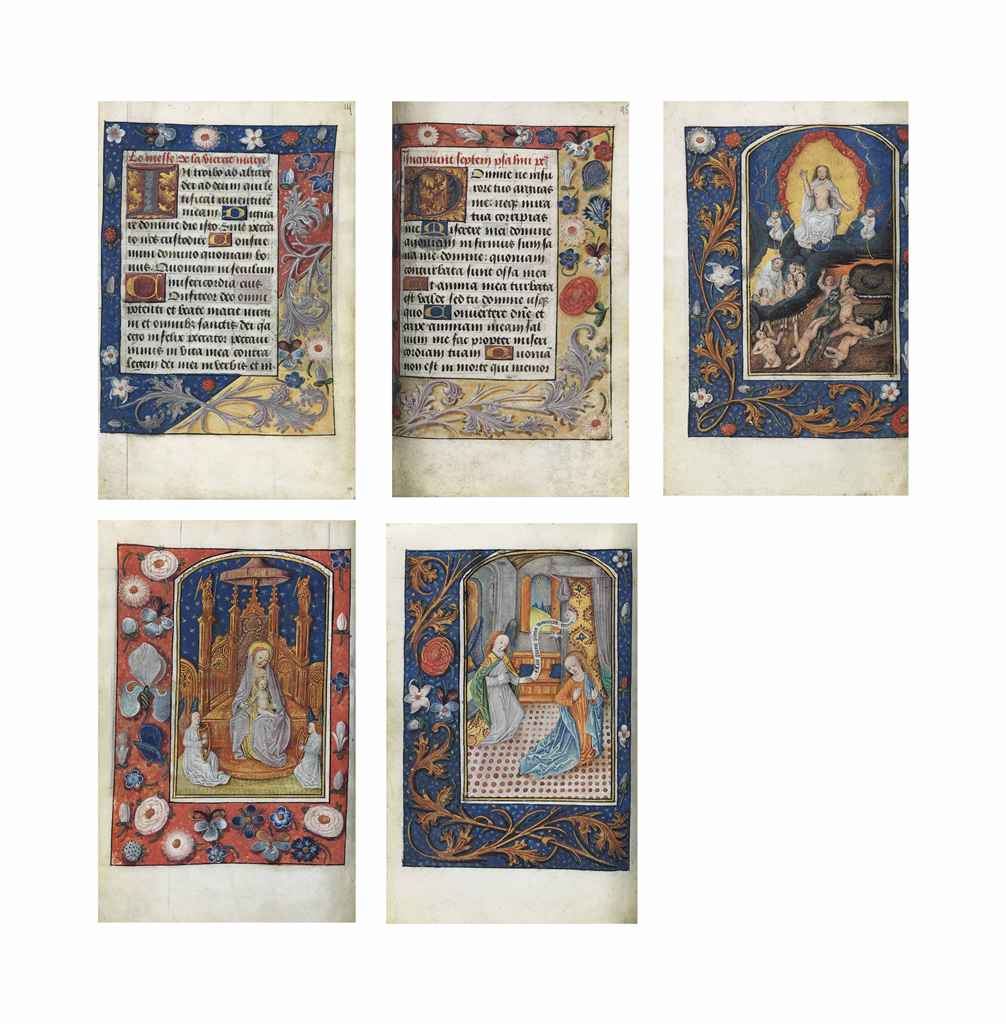
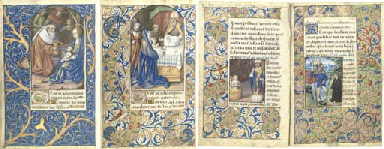
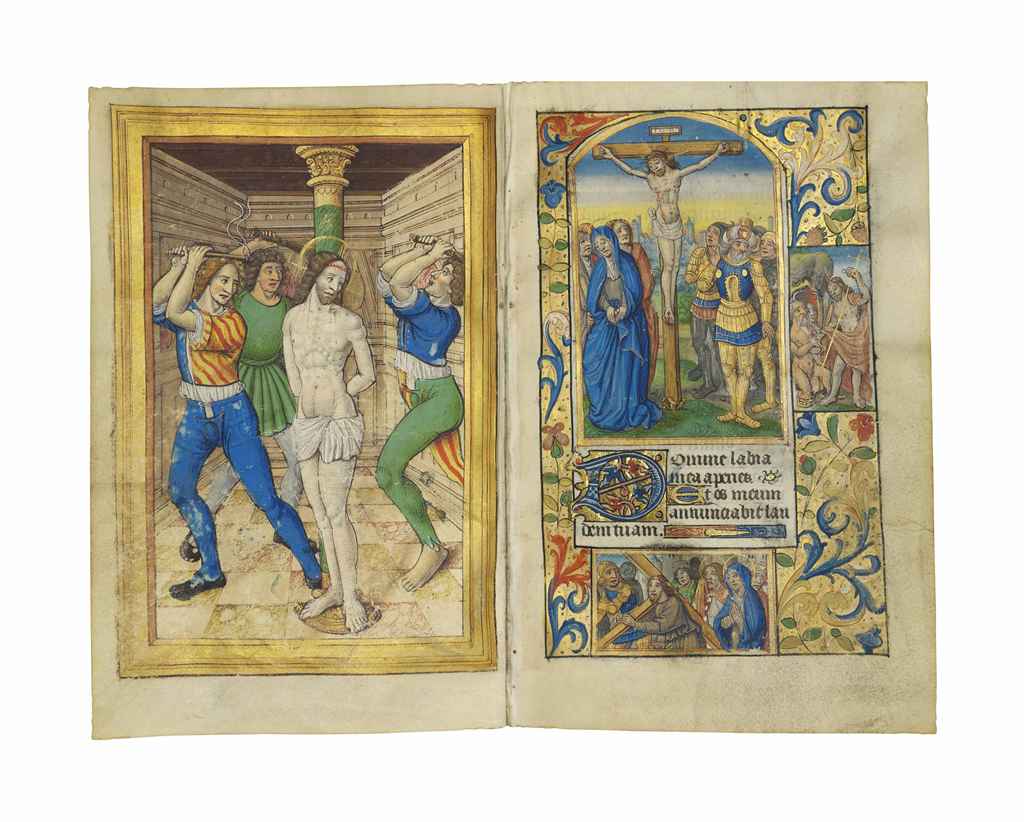
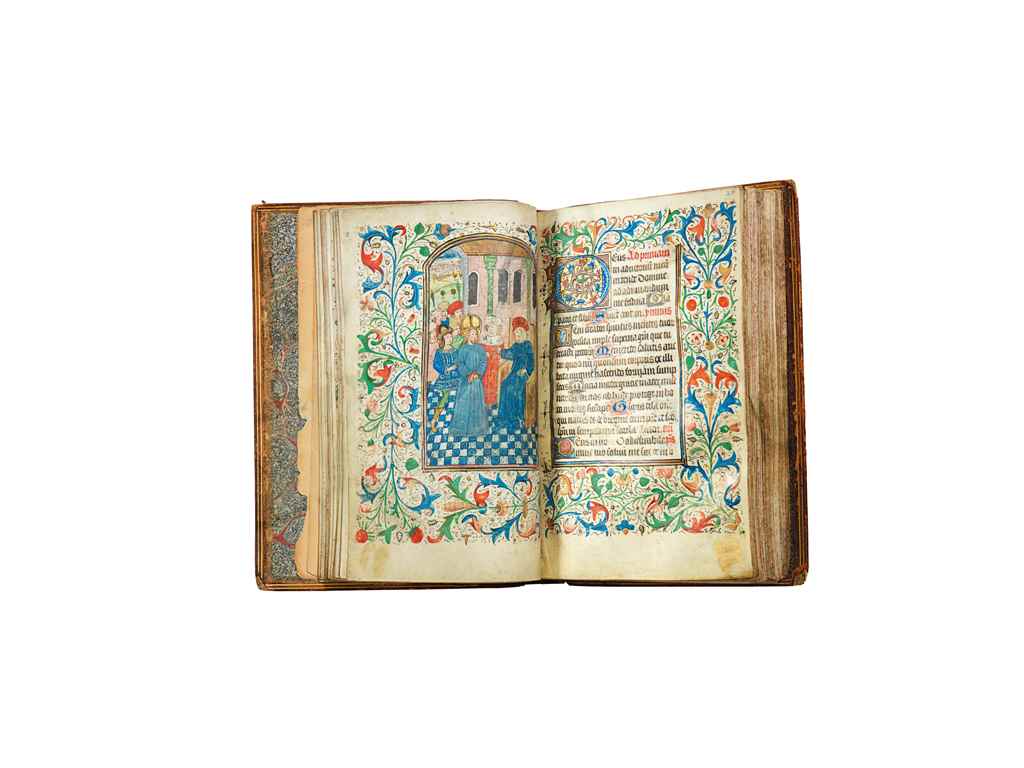


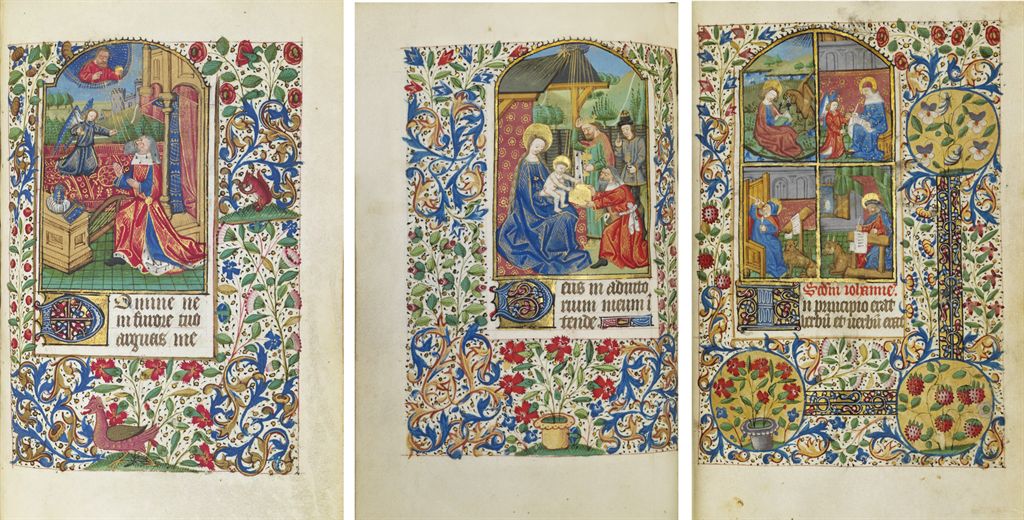
.jpg)


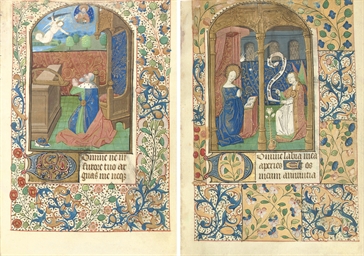
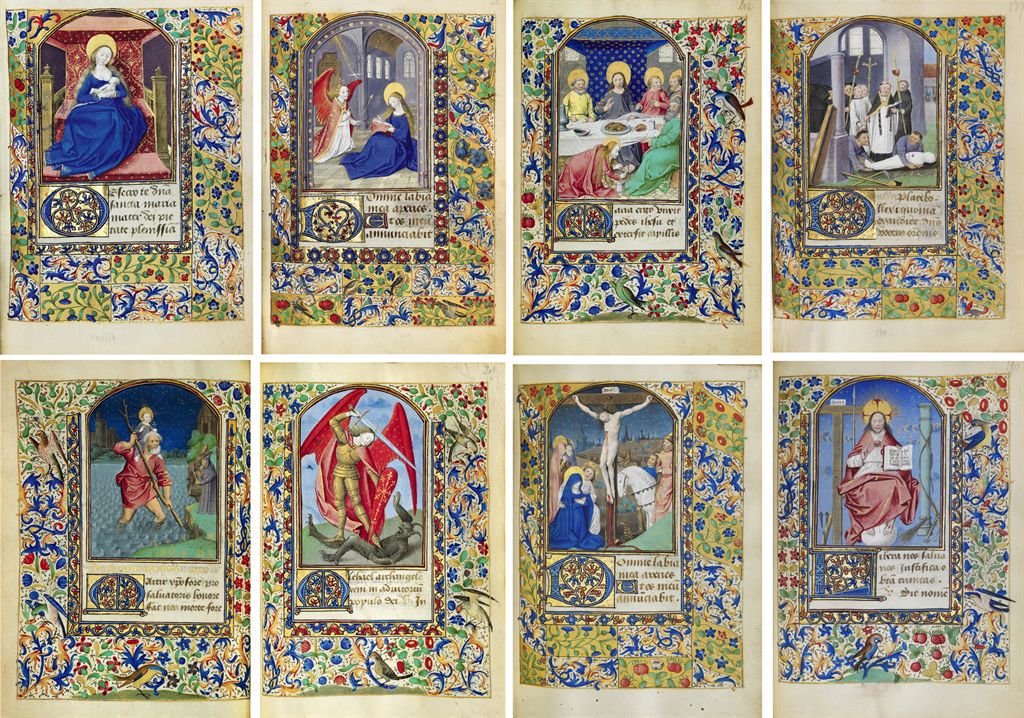
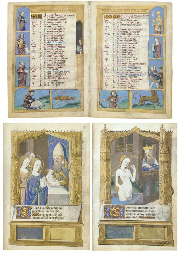
Try LotSearch and its premium features for 7 days - without any costs!
Be notified automatically about new items in upcoming auctions.
Create an alert